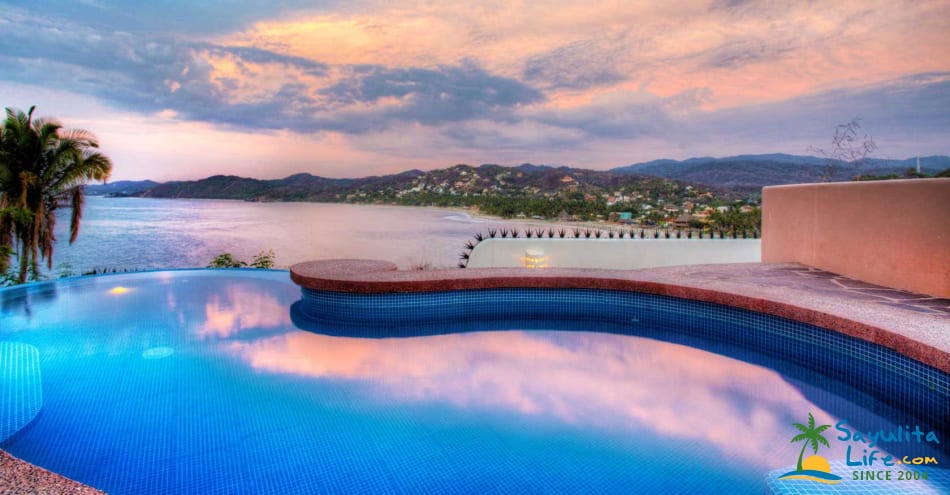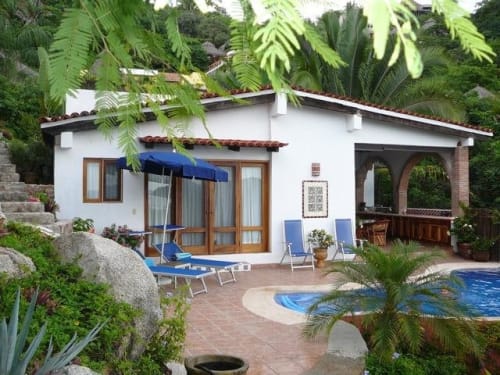Sayulita Mexico news article originally
posted in Travel & Leisure magazine
Author: Christopher Petkanas
Original Article Link: Travel + Leisure Magazine
Two nights were all I had budgeted in PV. Any longer and its allure starts to thin. The town gets on your nerves. All those trinket peddlers and serenading Los Ponchos wannabes. But it's a great gateway. The Bay of Banderas sweeps through the states of Jalisco and Nayarit in a 27-mile arc from Villela in the north to Corrales in the south. Its secret beaches and tangled hills hold all the clues to what PV was like 40 years ago.
Sayulita, 26 miles up the coast, was a picturesquely impoverished fishing village when the first brave American surfers appeared there in the early seventies. The jungle was so dense (and full of scorpions and wild parrots), they basically had to hack their way to what would become known as one of Mexico's most sensational boarding waves—1,000 feet long on a normal day, 1,600 on a good one, and with swells that top off at eight feet. Everything changed when the highway that connects PV and Sayulita was finished in 1998. U.S. license plates were seen for the first time. Tourism gave villagers the means to trade their burros for horses, and then their horses for cars. The really decisive year was 2003, when the foundations were laid for Villa Amor, a hulking 33-room "luxury" hotel that made its Californian developer, Rod Ingram, possibly the least popular person this side of the Sierra Madre. Residents succeeded in blocking the project for a while, but Ingram ultimately prevailed, taking advantage of the slack system then in place to push it through. Villa Amor would never have a chance today. Anticorruption under President Vicente Fox, the one-time Coca-Cola delivery truck driver, is huge, a man who just paid $1 million for 1½ acres on the water in Sayulita told me. Gone are the days when you could flip the building inspector a $20 bill to look the other way. Now, he says, the inspector would flip you in jail before sunset.
For better or worse, Sayulita has grown into one of those high-low places where you can drop $1,800 on a leather-and–baroque pearl Les Gazelles necklace in a boutique where the merchandising is as edgy as Barneys', then waltz out past a real estate office with the Christie's logo and have the best fish taco in the world from a cart on the street for 85 cents. Sayulita's streets are dusty, exhausted, bedraggled. The village is definitely not for your stepmother, probably not for your in-laws, and, sadly, not for you if you are not enchanted by these traits. Those who are have nice things to say about the locals. As one American put it, they greet you before you greet them, and unlike the native populations in other parts of Mexico, such as the states of Durango and Guerrero, they don't make you feel like a foreigner, an outsider, a gringo. People who move to Sayulita are drawn by the leveling mix of ages, incomes, backgrounds, and lifestyles. Everyone converges on the sand to ritually toast the sunset: the fishermen, the fishermen's wives, their children, the surfers, the dropouts, the deadbeats, the beach bums, the retirees, the newly arrived nobody can remember anything identifying about except that they have gobs and gobs of money.
Like the tacos, Sayulita's other street food—flan sold by a young mother at a card table; chicken marinated in orange juice, mayonnaise, garlic and chiles and grilled by Yolanda on Calle José Mariscal—is safe, cheap, sustaining, and delicious. The village wakes up around eight (rather early, I thought, for such a lazy place) at Choco Banana, located on the main plaza downwind from the butcher's shop, where a cauldron of pigs' organs bubbles ominously outside the front door. Choco Banana has luscious breakfast burritos, the frozen specialty that gives the place its name, and morning surfer-watching that is as hot, er, as the coffee. Even at this hour, someone on the square is usually blowing softly on a saxophone, while at a stand opposite the café a Huichol Indian plies his shamanistic art: reptiles rendered in infinitesimal, vividly colored beadwork.
Strips of mahimahi coated in a dark beer–and-garlic batter fill the handmade stone-ground–masa tortillas at Sayulita Fish Taco. The pineapple-and-mango salsa here is so crazy-good, no one can be bothered to notice that a taco costs four times what it does on the street. The guy next to you at Sayulita Café could be a Mexican-food geek on a molcajete azteca odyssey. Piled into a volcanic-stone bowl, the dish combines beef, chicken, chorizo, panela cheese—and cactus, the whole bathed in a dark, smoky chipotle sauce. Sayulita entered a definitive era of no looking back with the opening of El Espresso coffee company, whose owner does not hesitate to call herself a barista, and Fiambala, an Argentine steak restaurant with a real Argentine chef and tables set out in a pretty garden courtyard. When they run out of mozzarella at Don Pedro's, the "fancy" dining option on the beach, the pizzas are piped with mashed potatoes. The Cuban salsa band and flamenco guitar duo are better than the food. And who but tourists, for heaven's sake, are buying the hibiscus wine at Los Sabores de Sayulita, an entire store devoted to the stuff?
Given the smudged visage the town shows visitors, the services and shopping are as surprising as the food scene. Why a surfer might need the "innovative" lawyering skills of MJ & Co., a firm that specializes in trademarks and copyright, I can't think. But I suppose you never know. Painting and slicing are among the coloring techniques Graziella Jones and John James, Vidal Sassoon–trained stylists from England, have on the menu at their Jungle Hair Design salon. Fleur d'Oranger offers shiatsu, Reiki, and a range of products—volcanic-clay mask, almond-and–aloe vera exfoliant, orange-blossom toner—created exclusively for the boutique by Veroushka Tarazi, a "clinical essence therapist," whatever that is.
Smelling like a piece of Moroccan pastry, you can head across the street to Jaeti, which goes narrow and deep into lovely artisanal jigsaw puzzles, then over to Yemaya for practically invisible Brazilian bikinis from labels like Bumbum and Poko Pano. La Hamaca is the finest shop for folk art and crafts in the village but also the most overpriced, though the silkiness of a string hammock did convince me that it was somehow worth $135. Around the corner, Gypsy Gallery is an overstuffed bazaar of tiles, pareus, antique oriental rugs, Day of the Dead papier-mâché figures from the annual fair in Patzcuarao, Guatemalan textiles, satiny black Oaxacan pottery, hand-loomed bedspreads, hand-embroidered pillow slips, hand-tooled leather bags, and hand-painted wooden bowls, plates, and trays. Copper mirrors, candlesticks, and jewelry are brought in from Santa Clara del Cobre. Anything that can be fixed with the image of Frida Kahlo, is.
Frida T-shirts are fun, as far as they go. Hunters of big retail game prefer Pachamama, a showcase for the Les Gazelles line of ready-to-wear, accessories, and pearl-and-leather jewelry (shells and eagle, flamingo, and peacock feathers are also sometimes used) of Nathalie Mignot and Laurence Mignot Hodge, who market themselves as beautiful nomads and citizens of the world. Their idea of a skirt is five inches of snakeskin and lamé leather animated with two bushy tassels. For the rest of us there are terra-cotta bowls from Guadalajara with swirls or dots, and the lengths of loosely woven striped cotton that Mexican farmers use as bedsheets but that the Mignot girls think are more amusing as beach towels. For $1,200 a day—which buys seven bedrooms, three baths, a sprawling mezzanine for sleeping under the stars, a maid, a cook, breakfast, surfboards, long boards, and snorkeling gear—you can imbibe the French sisters' chic by renting Les Oiseaux Volants, their largely open-air duplex directly above the store.
Villa Amor has two things going for it: sweeping ocean vistas and a sexy room concept that does away with outside walls and invites you to see Sayulita through a rustling fringe of palm fronds. But the execution is ham-fisted, the opposite of luxe: if God is in the details, you will not find Him here. Amor is supposed to be a full-service hotel, but no one ever seemed to be able to do anything for me. Six times over three days I asked for cushions for the bony iron longues on my terrace, and six times they never came. I would have been much happier at Petit Hotel d'Hafa or Haramara Retreat. Owned by the Mignots' brother Christophe and his Spanish wife, Marina, unofficially the best-looking couple in Sayulita, the six-room Hafa is a winsome bit of Morocco in the middle of town just steps from the water, with barrel-vaulted ceilings, chartreuse polished-cement floors, and pierced-tin wall lights in the shape of angel wings. Straw mats are stenciled with hearts, crescents, and Pop art flowers, and hand-tempered copper jam basins do the job of bathroom sinks. Haramara is a serenely stylish (biomorphic walls, floors embedded with beach stones), magnificently groomed yoga-and-meditation compound that accepts nonpractitioners without making them feel like second-class guests. Sixteen palapas, scattered on a jungle bluff overlooking the Pacific a few minutes out of town, have no electricity, only kerosene lamps and candles. The wildlife is terrifying. Coatis, which resemble a cross between a raccoon and a monkey, are adept at undoing the most securely zipped suitcases and helping themselves to the fruit you thought was safe inside. A woman who lives nearby left her house one morning to do the marketing and returned to find a boa constrictor half asleep on the kitchen table. It had just eaten her cat.
Whether or not they choose to call it slumming, people staying eight miles down the road in Punta Mita do get a thrill racing in and out of Sayulita, loading up at Pachamama before returning to the gated security and branded comforts of the 178-room Four Seasons Resort. Punta Mita is a grandiose 1,500-acre master-planned development of which the hotel is just one component. A 120-room St. Regis Resort opens early next year, to be followed in 2010 by a third hotel, La Solana, which will almost certainly be another Four Seasons. Tim Koogle, the former chairman and founding CEO of Yahoo, bought a 125-acre plot near Punta Mita in 2003 to build a boutique hotel and what can only be described as "McHaciendas."
Can't quite commit to owning? Maybe you're part of the emerging "entourage travel" market. At the Four Seasons, a 9,150-square-feet private casita with five bedrooms, a media room, a fitness center, a "personal host" who never sleeps, and a waterway that snakes through the interior goes for $15,000 per night. No word on whether this is where Britney Spears, fresh from rehab, and her cousin Allie stayed in June, when pictures of the former starlet snapped at the resort had the blogosphere wondering if she'd combed her hair with guacamole.
For the price of a Four Seasons cabana—$300 per day in high season—you could stay three nights at the Hafa in Sayulita and get change back. Within a cabana's two hard and two curtained walls are a sumptuous daybed mounded with cushions, a 42-inch plasma TV, and a mini-bar stocked with sunblock and an eye mask filled with coolant. Pick up the phone, and before you have time to put down your paperback the spa sends someone with all the fixings for a chilled-margarita manicure. If it's two o'clock it must be time for a visit from the sunglass doctor, who cleans, tightens, and makes the scratches disappear from your shades. Every hour a staffer comes by proffering some little temptation: unfermented palm wine, frozen fruit, lassi, a piña colada "whip." The bar lays on six kinds of caviar. And you thought there was a world caviar crisis.
Anyone who has had his feet rubbed with lime juice, salt, and tequila knows you have to come down to earth sometime. Yelapa lies south of PV, 45 miles from Punta Mita, and is accessible only by boat, by mountain bike, or on foot. To reach the Verana hotel from the shore, you take a 15-minute donkey ride through steep jungle—a little jostly, as you'd expect, but also very exciting. Up top, the landscape opens up rather suddenly to disclose the bay below and, over your shoulder, the Sierra Madre Occidental. Like the views, the eight guest rooms are exhilarating but at the same time extremely peaceful. They follow the same indoor-outdoor principle as Villa Amor's, but with guts, style, and emotion. Heinz Legler, Verana's architect, loves half-walls, but no walls even more. The toilet was the only enclosed part of my bathroom, i.e. the washbasin was completely out in the open. Do you shave in the nude?
The look of sophisticated rusticity Legler favors is shared by his wife, Veronique Lievre, who decorated the hotel with a cocktail of Mexican handicrafts, found objects, flea-market bits and bobs, old milking stools, wrought-iron sling chairs of her own creation, George Nelson lighting, and twig furniture made on-site by the groundskeeper. People this design-centric rarely have a corresponding interest in food, but Lievre and Legler break the mold. Their restaurant is one of the best on the Bay of Banderas, serving red snapper grilled whole on a stick, coconut-mango sticky rice, and lemongrass crème brûlée.
Yelapa's population of 1,500 was introduced to the pleasures of electricity just five years ago and is still waiting to discover those of the automobile, though if cars do make it, there'll be nowhere to drive them. The Tuito River slices through the village, emptying into the Pacific, and in the rainy season you have to wade across to get from one side of Yelapa to the other. Occasionally the calm is broken by a farmer and a pack of dogs giving chase to an escaped bull. Someone should make a movie.



